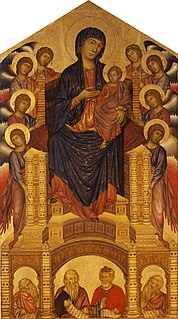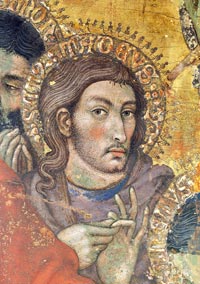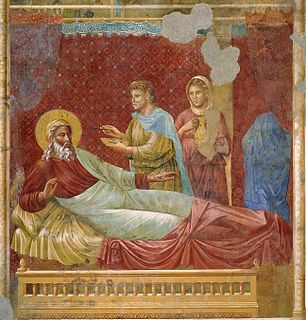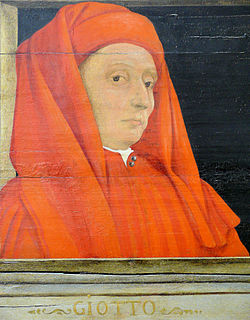
Cimabue, also known as Cenni di Pepo or Cenni di Pepi, was an Italian painter and designer of mosaics from Florence.

Domenico di Tommaso Curradi di Doffo Bigordi, professionally known as Domenico Ghirlandaio, also spelled as Ghirlandajo, was an Italian Renaissance painter born in Florence. Ghirlandaio was part of the so-called "third generation" of the Florentine Renaissance, along with Verrocchio, the Pollaiolo brothers and Sandro Botticelli. Ghirlandaio led a large and efficient workshop that included his brothers Davide Ghirlandaio and Benedetto Ghirlandaio, his brother-in-law Bastiano Mainardi from San Gimignano, and later his son Ridolfo Ghirlandaio. Many apprentices passed through Ghirlandaio's workshop, including the famous Michelangelo. His particular talent lay in his ability to posit depictions of contemporary life and portraits of contemporary people within the context of religious narratives, bringing him great popularity and many large commissions.

Simone Martini was an Italian painter born in Siena. He was a major figure in the development of early Italian painting and greatly influenced the development of the International Gothic style.

Pietro Lorenzetti or Pietro Laurati was an Italian painter, active between c.1306 and 1345. Together with his younger brother Ambrogio, he introduced naturalism into Sienese art. In their artistry and experiments with three-dimensional and spatial arrangements, the brothers foreshadowed the art of the Renaissance.

Benedetto Bonfigli was an Italian Renaissance painter born in Perugia, and part of the Umbria school of painters including Raphael and Perugino. He is also known as Buonfiglio. Influenced by the style of Domenico Veneziano, Benozzo Gozzoli, and Fra Angelico, Bonfigli primarily painted frescos for the church and was at one point employed in the Vatican. His best preserved work is the Annunication, but his masterpiece is the decoration of the chapel of the Palazzo dei Priori. Bonfigli specialized in gonfaloni, a Perugian style using banners painted on canvas or linen. Little is known of his personal life, but he was an esteemed painter in Perugia before Perugino, who is said to be his pupil.

Pisanello, born Antonio di Puccio Pisano or Antonio di Puccio da Cereto, also erroneously called Vittore Pisano by Giorgio Vasari, was one of the most distinguished painters of the early Italian Renaissance and Quattrocento. He was acclaimed by poets such as Guarino da Verona and praised by humanists of his time, who compared him to such illustrious names as Cimabue, Phidias and Praxiteles.

Benozzo Gozzoli was an Italian Renaissance painter from Florence. A pupil of Fra Angelico, Gozzoli is best known for a series of murals in the Magi Chapel of the Palazzo Medici-Riccardi, depicting festive, vibrant processions with fine attention to detail and a pronounced International Gothic influence. The chapel's fresco cycle reveals a new Renaissance interest in nature with its realistic depiction of landscapes and vivid human portraits. Gozzoli is considered one of the most prolific fresco painters of his generation. While he was mainly active in Tuscany, he also worked in Umbria and Rome.

The Basilica of Saint Francis of Assisi is the mother church of the Roman Catholic Order of Friars Minor Conventual in Assisi, a town in the Umbria region in central Italy, where Saint Francis was born and died. It is a Papal minor basilica and one of the most important places of Christian pilgrimage in Italy. With its accompanying friary, Sacro Convento, the basilica is a distinctive landmark to those approaching Assisi. It has been a UNESCO World Heritage Site since 2000.

Taddeo di Bartolo, also known as Taddeo Bartoli, was an Italian painter of the Sienese School during the early Renaissance. He is among the artists profiled in Vasari's biographies of artists or Vite. Vasari claims he is the uncle of Domenico di Bartolo.

Assisi Cathedral, dedicated to San Rufino is a major church in Assisi, Italy. This stately church in Umbrian Romanesque style was the third church built on the same site to contain the remains of bishop Rufinus of Assisi, martyred in the 3rd century. The construction was started in 1140 to the designs by Giovanni da Gubbio, as attested by the wall inscription visible inside the apse. He may be the same Giovanni who designed the rose-window on the façade of Santa Maria Maggiore in 1163.

The Master of Saint Francis was an anonymous Italian painter, perhaps of Pisan origin though probably trained in Umbria, working between 1250–1280. His work embodies an important aspect of the Italo-Byzantine style resulting from contact between Italian and Byzantine art of this period.

Cristofano or Cristoforo Gherardi, also known as il Doceno, was an Italian painter of the late-Renaissance or Mannerist period, active mainly in Florence and Tuscany.

Fra Paolino da Pistoia OP was an Italian painter of the Renaissance period, active in Tuscany. He was a son of the painter Bernardino del Signoraccio. He was a Dominican friar who painted in a style similar to Fra Bartolomeo.

The Lives of the Most Excellent Painters, Sculptors, and Architects, often simply known as The Lives, is a series of artist biographies written by 16th-century Italian painter and architect Giorgio Vasari, which is considered "perhaps the most famous, and even today the most-read work of the older literature of art", "some of the Italian Renaissance's most influential writing on art", and "the first important book on art history".

Bartolomeo Caporali was an Italian painter and miniaturist in Perugia, Umbria during the early Renaissance period. His style was influenced by Umbrian artists Gozzoli and Boccati, two of his first mentors, and continued to evolve as younger Umbrian artists came onto the scene, such as Fiorenzo di Lorenzo, Perugino and Pinturicchio. Although primarily a painter, he is also known for executing missals, restoration work, gilding, armorials, banners and celebratory decorations, which speaks to his decorative, detail-oriented artistic style. His most famous works include Madonna and Saints (1487) for the church of Santa Maria Maddalena at Castiglione del Lago, The Virgin and Child Between Two Praying Angels, and his Adoration of the Shepherds.

The Isaac Master was an Italian Gothic painter active in the decoration of the Basilica of San Francesco d'Assisi in Assisi at the end of the thirteenth century. Master's name is derived from a fresco painting of the death of Isaac for which he is known, the fresco is located in the Upper Church of St Francis at Assisi, depicting Isaac blessing Jacob and Esau.

Giotto di Bondone, known mononymously as Giotto and Latinised as Giottus, was an Italian painter and architect from Florence during the Late Middle Ages. He worked during the Gothic/Proto-Renaissance period. Giotto's contemporary, the banker and chronicler Giovanni Villani, wrote that Giotto was "the most sovereign master of painting in his time, who drew all his figures and their postures according to nature" and of his publicly recognized "talent and excellence". Giorgio Vasari described Giotto as making a decisive break with the prevalent Byzantine style and as initiating "the great art of painting as we know it today, introducing the technique of drawing accurately from life, which had been neglected for more than two hundred years".

Dono Doni, also known as Adone Doni or Dono dei Doni (1505-1575) was an Italian painter of the Renaissance period active mainly in Umbria.

Zanobi di Benedetto di Caroccio degli Strozzi, normally referred to more simply as Zanobi Strozzi, was an Italian Renaissance painter and manuscript illuminator active in Florence and nearby Fiesole. He was closely associated with Fra Angelico, probably as his pupil, as told by Vasari. He is the same painter as the Master of the Buckingham Palace Madonna. Most of his surviving works are manuscript illuminations but a number of panel paintings have also been attributed to him, including seven altarpieces and six panels with the Virgin and Child, along with some designs for metalwork.

The Assisi Diocesan Museum, in the city of Assisi, was founded in 1941 by bishop Giuseppe Placido Niccolini to preserve the most important works of art of the Assisi Cathedral and of several oratories of Assisi's confraternities. The museum is located underneath the piazza of the cathedral and has a collection consisting of about 300 works of which 100 are on display, exhibited in the museum's nine sections.




















